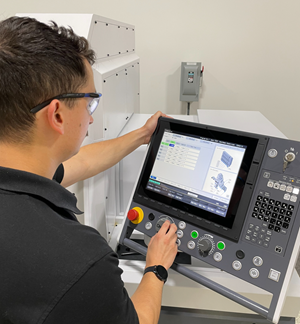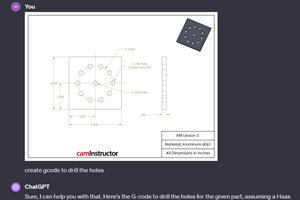Orthopedic Event Discusses Manufacturing Strategies
At the seminar, representatives from multiple companies discussed strategies for making orthopedic devices accurately and efficiently.
Share






On April 18 of this year, a group of OEMs held the Efficient Manufacturing of Orthopedic Implants seminar, a conference that explored the technology and techniques on the cutting edge of manufacturing medical implants. The seminar took place in Warsaw, Indiana, and was hosted by GF Machining, DLyte, Seco Tools, Open Mind and Zeiss — all of whom provided speakers discussing specific areas of technology as it related to medical manufacturing.
GF Machining’s Erik Poulsen spoke about ways to improve precision in manufacturing knee implants.
Ali Madari, a managing partner for Avicenne Medical, provided the keynote speech, focusing on the makeup and outlook of the medical manufacturing market. According to Madari, the orthopedic market is thriving, selling $51 billion in 2023 — a 6.2% increase from 2022. Madari further pointed out that many smaller companies had experienced double-digit growth in that period. With this growth, it is likely that these smaller companies are looking for contract manufacturers to meet their supply goals, making them ideal customers for high-mix shops looking for medical work.
Subsequent speakers spoke about a range of topic, focusing chiefly on the technology and practices that enable medical manufacturers to produce high-quality parts profitably.
- GF Machining’s medical market segment manager Erik Poulsen spoke at length about the keys to success in manufacturing knee implants, including ways to prevent errors from creeping into processes. Speaking on machine tool design, he recommended machines that use linear motors over ballscrews, which can experience “backlash” during directional changes. Other important features include intelligent thermal compensation and the use of polymer concrete bases, which can enable cooling features in addition to providing damping. He also spoke about the potential uses of supercritical CO2 in medical manufacturing, a technology GF machining has been working hard to support for medical machining.
- Chris Gamble, an account manager from Open Mind, spoke about CAD/CAM tools in HyperMill that aid in machining orthopedics. He covered features such as Global Fitting, which removes irregularities and repairs surface feature representation on the computer. He also discussed how to use overlapping toolpaths on curved surfaced to improve the finish, and he spoke at length about Open Mind’s programming options for machining with barrel cutters.
- Seco Tools’s Dominic Connor discussed cutting tool geometry as it related to orthopedic machining. While his presentation had general advice, such as the need for negative rake angles when cutting harder materials to protect the edge, he emphasized that cutting tool choices need to be based around the part being cut. Questions like whether the tool needs wipers and what coating to use are process-dependent, so the tool choice must fit the part. “We’re building tools for where they’re going,” Connor said. “We match the features to the needs of the final part.”
- Luis Hernandez – a technical sales engineer for Zeiss – spoke at length about QA challenges for orthopedics, especially focusing on scanning technology that can validate the dimensions of complex parts. Being able to quickly and accurately validate parts is particularly valuable in manufacturing orthopedic implants because many are customized to the patient, which means that every part must be inspected rather than inspecting a certain number from each batch. He mentioned multiple solutions, such as a confocal white light sensor that enables the measurement of depth, in addition to length and width, without needing to probe features.
- DLyte COO Patrick Sage spoke at length about the company’s unique dry electropolishing technology, which uses polymer beads injected with acids to achieve the desired finish. Users submerge parts in the DLyte beads, and the process of ionic transfer smooths away the microscopic peaks along the surface of the part. In contrast with standard electropolishing, the user does not need to handle acid, nor do they need acid clinging to the grooves of the part. Additionally, using this process prevents microscratches that can result from other finishing technologies, which can serve as places for bacteria to gather on otherwise sterile implants.
Other speakers and topics included:
- Sean Noonan, Applications Manager at GF — Planning automation around part needs
- Alan Levine, Managing Director at Open Mind — Improving process safety through CAM tools and other software
- Joe Mecus, Business Development Manager at Seco Tools — The importance of collaboration in cutting tool design
- Raghu Bhogaraju, Business Manager for Metrology Service Labs at Zeiss — Using computed tomography in quality inspection
Notably, the speakers at the event were committed to its mission — providing an educational discussion for the benefit of manufacturers. Rather than focusing on sales pitches, every talk given here was focused on how to use technology effectively, and if the frequency and depth of audience questions are any indicator, attendees appreciated this approach.
According to Seco Business Development Manager Joe Mecus, the feedback from the audience was as important as the talks. “The value of our product enhancements came to be through years of collaboration and testing different process theories,” he says. This collaboration between Seco and its customers as well — as between OEM partners (as in this event) — creates a fuller view of how to improve the manufacturing process, Mecus says. “The full end-to-end process is considered holistically, instead of one piece at a time.”
Seco Medical Global Business Development Manager Andrew Fielding concurred: “Our sessions were not just about imparting knowledge; they were about fostering meaningful connections and co-creating solutions that propel our industry forward.”
Related Content
Swiss-Type Control Uses CNC Data to Improve Efficiency
Advanced controls for Swiss-type CNC lathes uses machine data to prevent tool collisions, saving setup time and scrap costs.
Read MoreThe Power of Practical Demonstrations and Projects
Practical work has served Bridgerland Technical College both in preparing its current students for manufacturing jobs and in appealing to new generations of potential machinists.
Read MoreCan ChatGPT Create Usable G-Code Programs?
Since its debut in late 2022, ChatGPT has been used in many situations, from writing stories to writing code, including G-code. But is it useful to shops? We asked a CAM expert for his thoughts.
Read MoreContinuous Improvement and New Functionality Are the Name of the Game
Mastercam 2025 incorporates big advancements and small — all based on customer feedback and the company’s commitment to keeping its signature product best in class.
Read MoreRead Next
How I Made It: Dennis Rymanowski
Dennis Rymanowski has worked at NSH USA for 60 years, with his passion for manufacturing living alongside his passion for his family’s polka band.
Read MoreA New Frontier in Surface Finish Control
What if your machine tool could measure surface roughness as it cuts? This article explores how in-process metrology is advancing from concept to reality, enabling real-time feedback, immediate detection of anomalies and new levels of control over surface quality. Discover the technologies making this possible.
Read More






















